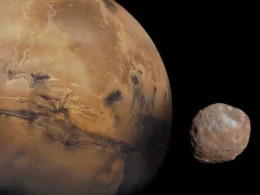Rosetta’s comet is giving up secrets older than the Solar System
Rosetta’s mission is very definitely over, but the information gathered about the comet it flew alongside is still producing new discoveries for astronomers.

After spending more than a decade in space and two years studying comet 67P/Churyumov-Gerasimenko, Rosetta touched down on the surface and stopped transmitting on September 30, 2016.
Now, more than a year later, scientists are sifting through the wealth of data Rosetta collected – and gaining a better understanding of the role comets play in our Solar System.
Onboard, Rosetta carried ROSINA (Rosetta Orbiter Spectrometer for Ion and Neutral Analysis), an instrument consisting of a pressure sensor and two mass spectrometers. ROSINA used the pressure sensor to map the density of the coma, the haze of dust and gas surrounding 67P/Churyumov-Gerasimenko itself, while the two mass spectrometers collected data on the coma’s chemical composition.
Knowing what the coma is made of is amazing enough – this is the first time we’ve ever made detailed measurements so close to a comet. What’s even more amazing is that ROSINA can give us clues as to how the coma might have formed. Its mass spectrometers can distinguish between different isotopes of the same element: these contain the same amount of protons (positively charged particles) in the atom’s nucleus, but different numbers of neutrons (particles which carry no charge). Different isotopes can reveal clues about how atoms or molecules were first synthesised.
Related: Rosetta finds key ingredients for life on comet’s surface
Related: We talk to Rosetta’s chief scientist on eve of crash-landing
In a presentation at the AVS (American Vacuum Society) 64th annual International Symposium, taking place in Tampa, Florida between October 29th and November 3rd, Kathrin Altwegg from the University of Bern in Switzerland described some of the results from ROSINA.
“What we found is amazing: Cometary ice is mostly older than the solar system, having survived its formation as ice,” said Altwegg. “This means the abundant organics found in the cometary coma are also probably older and therefore as such ‘universal’ – not specific to the solar system. If comets contributed to the emergence of life on our Earth, similar processes could have happened or could happen elsewhere in the universe.”
Another finding sheds light on a long-standing mystery: why does Earth have more water than any other rocky planet in our Solar System? One possible explanation was that our planet got its water from collisions with comets, but the Rosetta findings suggest that less than 1% of the water on Earth came from these collisions. Although this might not seem particularly helpful, it lets researchers know that they should focus their attention on other ways in which Earth might have become the watery planet we live on today.
ROSINA detected more organic material on the comet than was expected, which could hint at comets playing an important role in life emerging on Earth: “By looking at xenon isotopes we can also quantify how much organics they brought,” Altwegg said. “The unexpected richness of organics found in the cometary coma together with the results from xenon tell us that comets could have played an important role in sparking life on Earth.”
The results from Rosetta have shown us that comets are ancient and unique worlds, but our picture is still incomplete. While ROSINA was supposed to analyse 67P’s coma, the mass spectrometers onboard Philae, the lander, were supposed to analyse the comet’s surface. Sadly, Philae bounced on impact and although the lander still managed to take some photographs and some data, the mass spectrometers weren’t able to analyse the surface in as much detail as researchers had hoped.
As a result, says Altwegg, “we are missing the ground truth”. That’s not to say we won’t ever know what comets are like: in the future, landers could measure their surface and subsurface composition. Ultimately, we’d have a far better understanding of the ancient, icy rocks that might help reveal so much about our Solar System, our planet and even life itself.
Related: Over and out! Rosetta ends mission reunited with Philae
Related: Hale-Bopp – a comet that refuses to die
★ Keep up with space news and observing tips. Click here to sign up for alerts to our latest reports. No spam ever – we promise!

